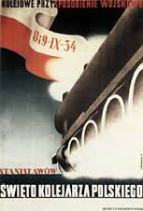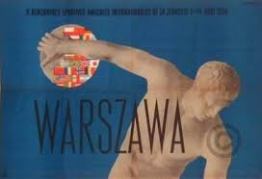World War II devastated Poland. Printing and graphic design, like so many aspects of Polish society and culture, virtually ceased to exist. It is a monumental tribute to the resilience of the human spirit that an internationally renowned Polish school of poster art emerged from this devastation.
Not only was much of Poland destroyed, the identity of Poland was greatly changed. After the war, Soviets rigged the post-war election to ensure the installation of a communist government. Poland would remain under Soviet influence and control until the collapse of the USSR in 1990. This heavy control influenced the world of art in Poland greatly. It was very difficult to pursue a career in graphic design after the war, and the number of graduates from art school was carefully controlled to equal the need for design. (Meggs)
One artist who did not lose hope for Poland was Tadeusz Trepkowski. Trepkowski was the first artist to emerge after the war. Trepkowski set a stage of tragedy and aspiration that would greatly influence the artists to follow in the Polish school of poster art. The poster became a source of great national pride in Poland. Trepkowski helped ignite the use of posters for a new source of communication in Poland, and a way to express dignity, ambition, and strength of the Polish people.
Trepkowski Film Posters 1948
Trepkowski was basically a self-taught artist. He pushed the minimalism approach to a new horizon and created some of the most effective visual communication posters. In these posters, he presented a mature individual style while maintaining a realistic convention, eliminating all unnecessary items. Before the war, Trepkowski collaborated with the Institute of Social Affairs to create posters devoted to occupational safety and health. In 1944, he reported to Lublin to work in the laboratory of propaganda poster at the main Board of the Political-Education Center of the Polish Army. He showed off a simple poster aesthetic that favored the literal object without any historic or stylistic allusions. He created a public service poster that showed, placed rhythmically across the poster, three hammer-holding hands and a fourth injured one, brought home the point that an injured hand cannot work. (Gizka)
The polish posters are characterized by a diverse range of international styles, including Expressionism, Constructivism, Functionalism, and Art Deco. One example of Trepkowski’s work that seems to be influenced by an international style is this announcement poster, created in 1934, which I think shows a strong art deco influence, especially of the work by Cassandre. (Austoni)
Trepkowski 1934
After World War II, poster art changed dramatically in Poland. Throughout the Stalinist era, from 1948 through the 1950s, Social Realist posters were a dominant presence. Art from this period was to be national in form and socialist in content, with iconic figures to inspire the public. Trepkowski used straightforward composition and pure color for the posters Nie! And Warszawa. He pared down the imagery only to what was important, specifically, a war ravaged city inside the outline of a bomb for the simple message “No!”, and a crane hoisting up “Warsaw” to urge the rebuilding of the capital. This strategy helped guide many poster artists in a new direction of effective communication. (MoMA) Even though Trepkowski did not have a large collection of major work, I think that he was one of the most important artists of the Postwar Polish Poster because he set the stage for many future artists. His work is an example of how artists communicate a strong message through their art which is greatly influenced by what is happening in their culture and society.
Trepkowski 1953 (left) and 1955
Meggs, Philip B, Alston W. Purvis. Meggs’ History of Graphic Design. Hoboken, N.J: J. Wiley & Sons, 2012. Print.
Rzepkowski, Kristinn. “Polish Poster Art”. Web. 3 Apr 2014. http://info-poland.buffalo.edu/classroom/poster/poster.html
Gizka, Sylwia. “Tadeusz Trepkowski”. Dec 2006. Web. 3 Apr 2014. http://culture.pl/pl/tworca/tadeusz-trepkowski
Austoni, Andrea. “The Legacy of Polish Poster Design”17 Jan 2010. Web. 3 Apr 2014. http://www.smashingmagazine.com/2010/01/17/the-legacy-of-polish-poster-design/
Museum of Modern Art. “Polish Posters”. Web. 3 Apr 2014. http://www.moma.org/visit/calendar/exhibitions/956





